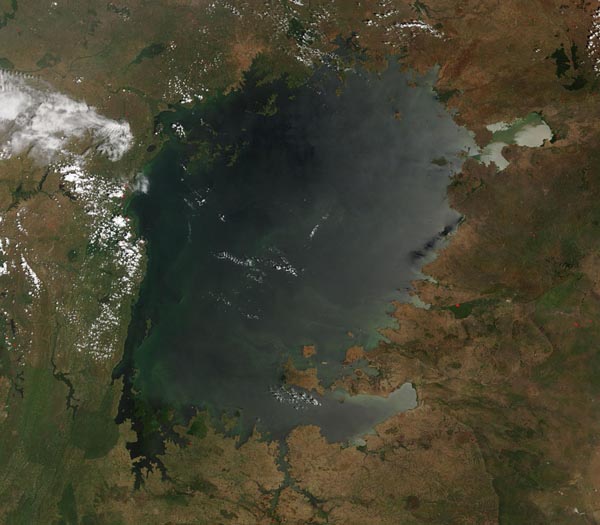Images
February 18, 2019 - Lake Victoria
Tweet
With a surface area of nearly 27,000 square miles (70,000 square kilometers), Lake Victoria is the biggest lake in Africa and the second largest freshwater lake in the world. The lake spans parts of three countries: Uganda (northwest), Kenya (northeast), and Tanzania (south), and is a major source of drinking water, hydroelectric power, and provides a livelihood for much of the region. The Lake Victoria fishery supports the livelihoods of millions of people in the Victoria basin, making the conservation of freshwater species and health of the lake of utmost importance to the region.
Lake Victoria has been feeling increasing pressure due to increasing agriculture, fishing, palm oil plantations, and other industry as well as population growth. The invasion of non-native aquatic vegetation, such as the water hyacinth (Eichhornia crassipes), also harms the ecosystem, as well as affects the livelihood of inhabitants. At times the water hyacinth grows so thickly that it prevents fishermen from being able to launch boats or navigate the usually blue waters.
In early 2018, the International Union for Conservation of Nature (IUCN) released a report on freshwater biodiversity in the Lake Victoria Basin aimed at assessing the extinction risk of 651 species of freshwater crabs, crayfish, shrimps, fish, mollusks, odonates (damselflies and dragonflies) and aquatic plants. Although 651 species seems like a lot, the study did not include several hundred species of haplochromine cichlid which live in sometimes remote areas of the lake. Many of these cichlids are popular in the aquarium trade and many are endemic to Lake Victoria. Because the report omits these, the rates of endemism are underestimated.
According to the IUCN report, fully 31% of the species living in Lake Victoria were found to be endemic (i.e., found nowhere else on Earth). Of the fish species living in the lake, fully 78% were endemic. The study also found that 20% of total freshwater biodiversity native to the Lake Victoria Basin is considered threatened, with a staggering 76% of the region’s endemic freshwater species threatened. Due to a lack of basic information, it was not possible to assess the extinction risk of 13% of native species and 38% of endemic species. Additionally, 8% of native species and 26% of endemic species are tagged as Possibly Extinct. The IUCN concludes that systematic biodiversity surveys and monitoring are urgently required, and also offers a number of suggested management strategies to persevere the lake’s biodiversity as well as protect the well-being of people who rely on the lake for water or livelihood.
The Moderate Resolution Imaging Spectroradiometer (MODIS) on board NASA’s Terra satellite acquired a true-color image of Lake Victoria on February 14, 2019.
Image Facts
Satellite:
Terra
Date Acquired: 2/14/2019
Resolutions:
1km (52.1 KB), 500m (149.7 KB), 250m (394.8 KB)
Bands Used: 1,4,3
Image Credit:
MODIS Land Rapid Response Team, NASA GSFC
Tweet
With a surface area of nearly 27,000 square miles (70,000 square kilometers), Lake Victoria is the biggest lake in Africa and the second largest freshwater lake in the world. The lake spans parts of three countries: Uganda (northwest), Kenya (northeast), and Tanzania (south), and is a major source of drinking water, hydroelectric power, and provides a livelihood for much of the region. The Lake Victoria fishery supports the livelihoods of millions of people in the Victoria basin, making the conservation of freshwater species and health of the lake of utmost importance to the region.
Lake Victoria has been feeling increasing pressure due to increasing agriculture, fishing, palm oil plantations, and other industry as well as population growth. The invasion of non-native aquatic vegetation, such as the water hyacinth (Eichhornia crassipes), also harms the ecosystem, as well as affects the livelihood of inhabitants. At times the water hyacinth grows so thickly that it prevents fishermen from being able to launch boats or navigate the usually blue waters.
In early 2018, the International Union for Conservation of Nature (IUCN) released a report on freshwater biodiversity in the Lake Victoria Basin aimed at assessing the extinction risk of 651 species of freshwater crabs, crayfish, shrimps, fish, mollusks, odonates (damselflies and dragonflies) and aquatic plants. Although 651 species seems like a lot, the study did not include several hundred species of haplochromine cichlid which live in sometimes remote areas of the lake. Many of these cichlids are popular in the aquarium trade and many are endemic to Lake Victoria. Because the report omits these, the rates of endemism are underestimated.
According to the IUCN report, fully 31% of the species living in Lake Victoria were found to be endemic (i.e., found nowhere else on Earth). Of the fish species living in the lake, fully 78% were endemic. The study also found that 20% of total freshwater biodiversity native to the Lake Victoria Basin is considered threatened, with a staggering 76% of the region’s endemic freshwater species threatened. Due to a lack of basic information, it was not possible to assess the extinction risk of 13% of native species and 38% of endemic species. Additionally, 8% of native species and 26% of endemic species are tagged as Possibly Extinct. The IUCN concludes that systematic biodiversity surveys and monitoring are urgently required, and also offers a number of suggested management strategies to persevere the lake’s biodiversity as well as protect the well-being of people who rely on the lake for water or livelihood.
The Moderate Resolution Imaging Spectroradiometer (MODIS) on board NASA’s Terra satellite acquired a true-color image of Lake Victoria on February 14, 2019.
Image Facts
Satellite:
Terra
Date Acquired: 2/14/2019
Resolutions:
1km (52.1 KB), 500m (149.7 KB), 250m (394.8 KB)
Bands Used: 1,4,3
Image Credit:
MODIS Land Rapid Response Team, NASA GSFC




